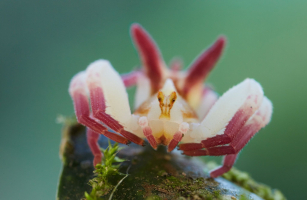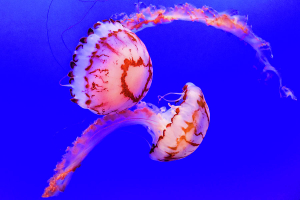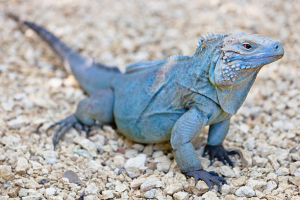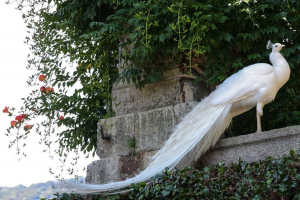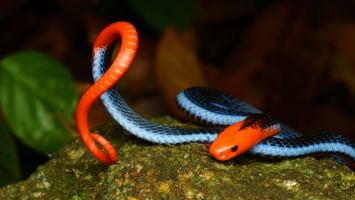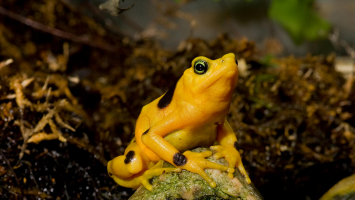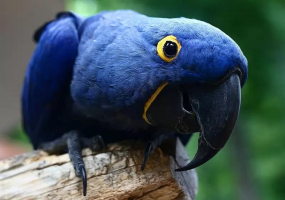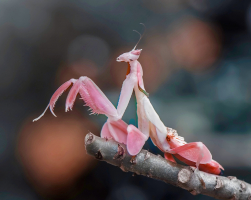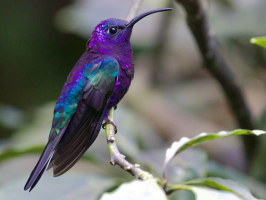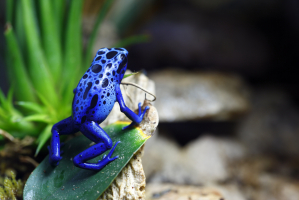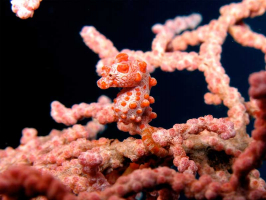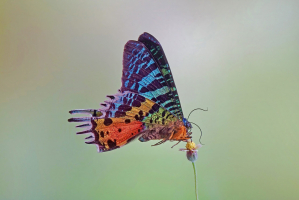Top 10 World's Most Beautiful Fish
It is estimated that 73% of Earth’s surface is covered by oceans, discovered many interesting species and still counting. Fishes are always one of the most ... read more...interesting species in the world because of their colorful patterns and beautiful fins. All of these fish are unique in their own way. Here is a list of the most beautiful fish in the world, let's find out!
-
An Indo-Pacific native genus of venomous marine fish is called Lionfish. It is distinguished by vivid warning coloration with red, white, creamy, or black bands, flashy pectoral fins, and venomous, spiky fin rays. It is also known as firefish, turkey fish, tasty fish, or butterfly-cod. The three most often investigated species in the genus are Pterois radiata, Pterois volitans, and Pterois miles. Species of Pterois are common aquarium fish. Recent and significant invasive species in the west Atlantic, Caribbean Sea, and Mediterranean Sea are P. volitans and P. miles.
Pterois are dangerous to people. Each species of juvenile lionfish has a distinct tentacle that is situated over their eye sockets. This tentacle's evolution is thought to have aided in the attraction of new prey on a constant basis. Studies also suggest that it aids in sexual selection. Pterois fish eat mostly on small fish, insects, and mollusks in vast quantities, with some specimens' stomachs having up to six different kinds of prey, according to a study that entailed the dissection of over 1,400 lionfish stomachs from Bahamian to North Carolinian waters.
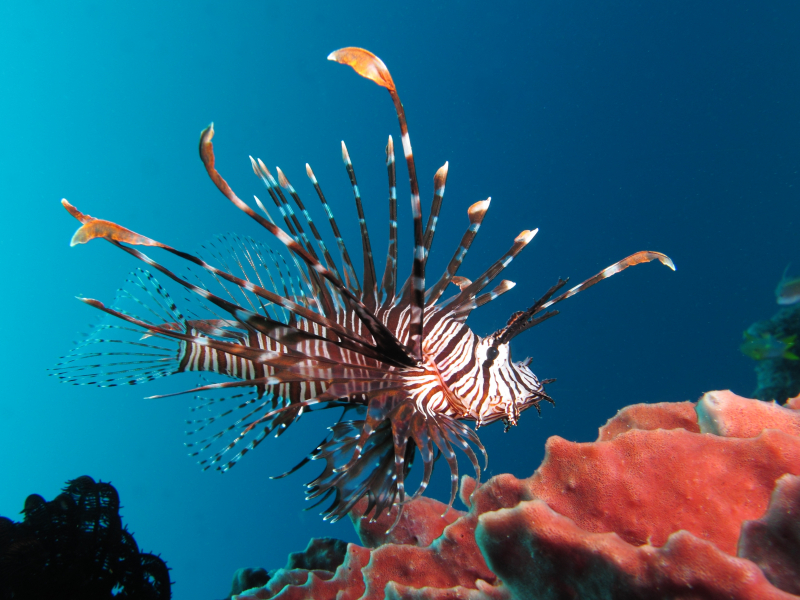
Wikipedia 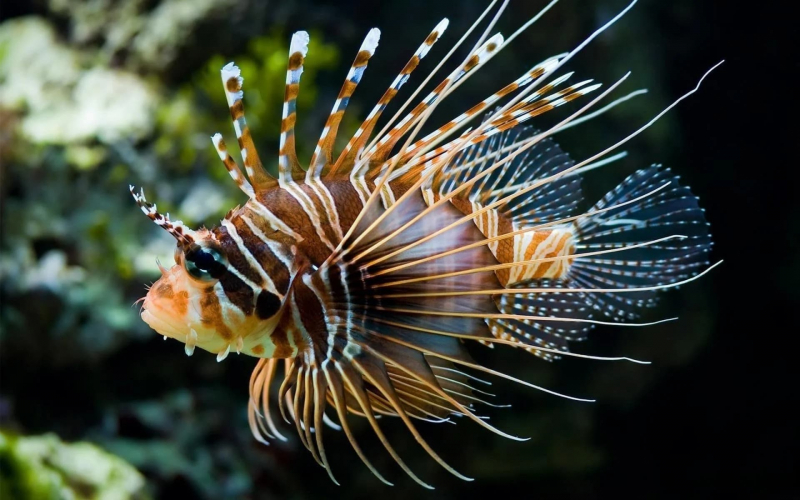
Sierra Club -
The Mandarinfish (Synchiropus splendidus), sometimes known as a mandarin dragonet, is a small, vividly colored member of the family of dragonets that is well-liked in the saltwater aquarium industry. The native range of the mandarin fish is in the Pacific, roughly from the Ryukyu Islands south to Australia. It frequently inhabits some of the warmer seas. The mandarin fish consumes a variety of foods, including fish eggs, ostracods, tiny gastropods, grammarian amphipods, and harpacticoid copepods. The fish selectively peck at small food trapped on the coral substrate in a home range of many square meters while feeding continuously throughout the day in the wild.
The only physical similarity between a goby and a mandarin fish is in their body shapes. The striking coloring features a swirling orange stripe on the face and a brilliant blue background with bold blue stripes. Large pelvic fins are often mistaken for pectoral fins because they are utilized for "walking" on the ocean floor. The actual pectorals are practically in the middle and are almost completely transparent, with the exception of the anal fins and a portion of the tail, which are brightly striped in orange and blue. Males have a very tall dorsal fin with eye-catching orange and blue pattern. Typically, the eyes are crimson with black pupils.
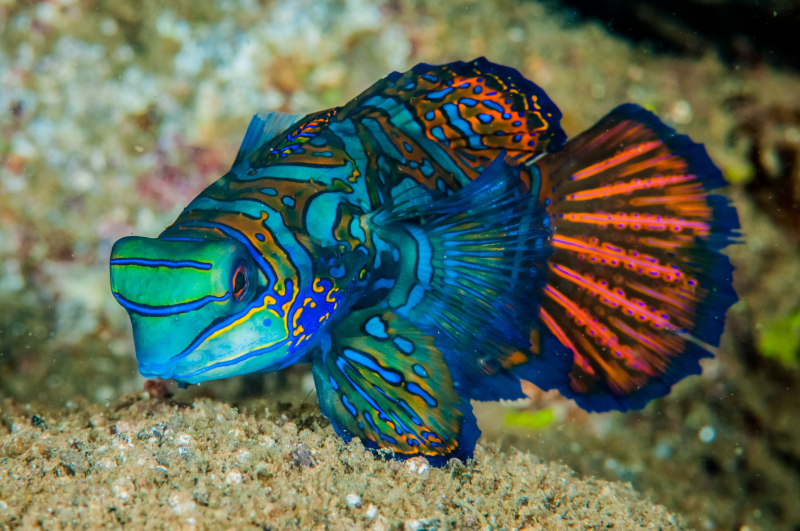
The Spruce Pets 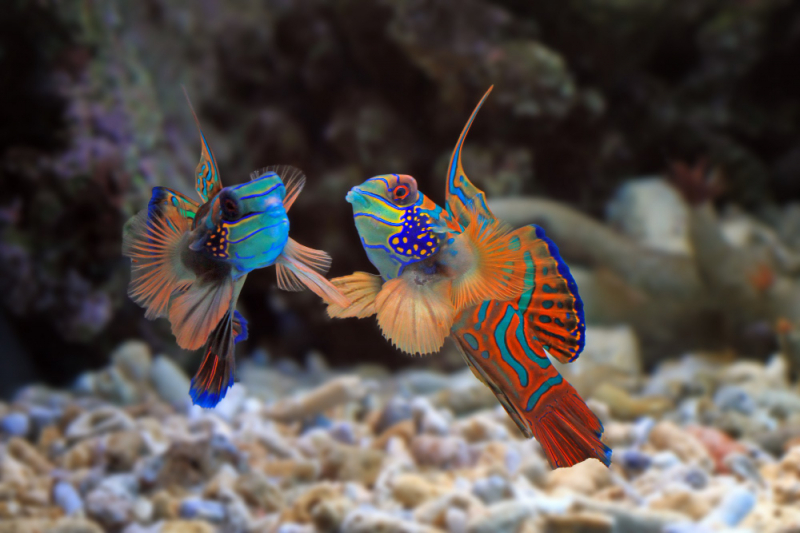
Fish Informer -
A type of marine angelfish is called the Emperor Angelfish (Pomacanthus imperator). It is a fish that lives near reefs and is found in the Red Sea, the Indian and Pacific Oceans, Hawaii, and the Austral Islands. This species typically has steady numbers and is not endangered in any significant ways. Because of its distinctive, vivid pattern of colors, it is a favorite among photographers, artists, and aquarists.
The emperor angelfish exhibits a clear distinction between its juvenile and adult forms. The bodies of the juveniles are dark blue with concentric curving lines that alternate between pale blue and white, the smallest of which are placed posteriorly and are totally encased within one another. At the front, these lines are vertical. The caudal fin is transparent, whereas the dorsal fin has a white edge around it. The adults have a light blue face with a dark blue mask covering the eyes, horizontal blue and yellow stripes, and a yellow caudal fin. Above the pectoral fins, there is a blackish band, the top of which is above the level of the upper orbit. The front margin of this band is bright blue and the rear margin is a thin yellow line. The anal fin has a dark blue background with light blue horizontal stripes.
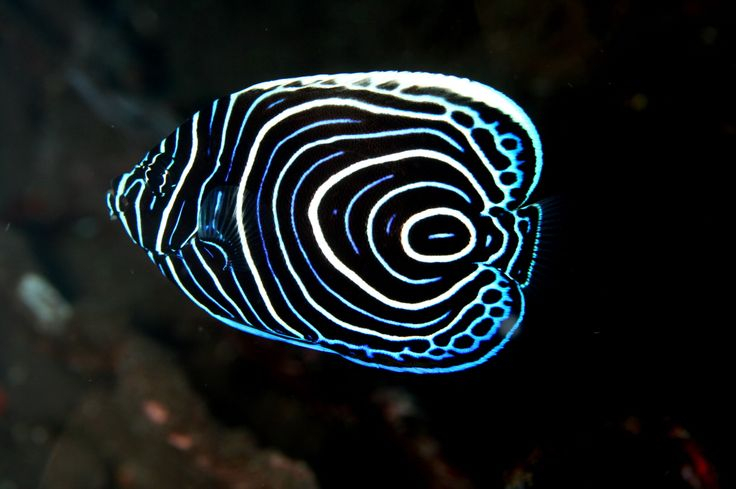
Pinterest 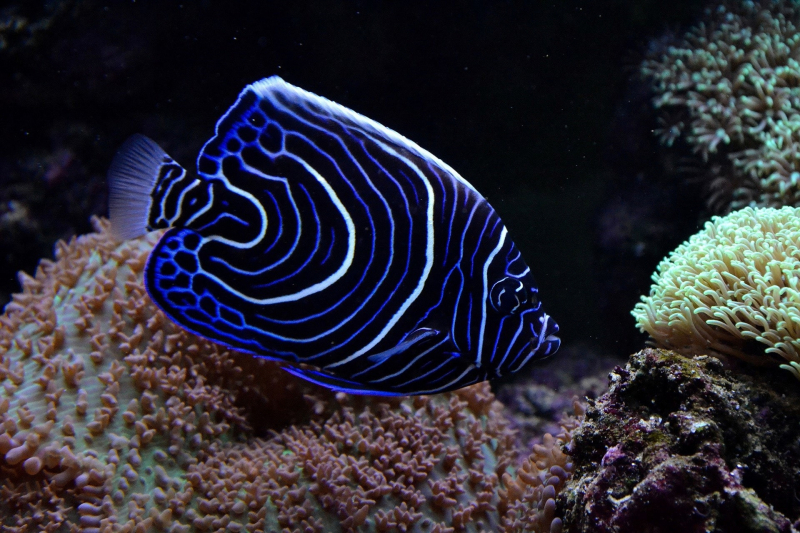
Snorkeling Thailand -
The Clown Triggerfish (Balistoides conspicillum), also known as the big spotted triggerfish, is a demersal marine fish belonging to the family Balistidae, commonly called triggerfish. The Indian Ocean's tropical and subtropical seas as well as the western Pacific Ocean have a large population of clown triggerfish. It is most frequently located in areas with clear water up to a depth of 75 m along exterior reef slopes. Juveniles typically remain below 20 m in a protected area near caves or overhangs.
A fish called a clown triggerfish can reach a length of 50 cm. Its body is oval in shape, compressed laterally, and appears stocky. Black is the color of the background. Large, more-or-less rounded white dots cover half of the body's inferior region. Yellowish sinuosities that run over the area around the first dorsal fin form a network that resembles the leopard's patterns. The mouth has a yellowish ring around it that is encircled by a second, white fin ring. Just below the level of the eyes, a white line rides the nose. The anal fin and second dorsal fin are white with a yellow line extending from the base of each fin. The caudal peduncle bears three horizontal rows of spiky scales with a yellowish splotch on top. The caudal fin has a black border and a yellowish center. Small white patches dot the black backdrop of juveniles, who also have a yellowish base to their first dorsal fin and snout extremity.
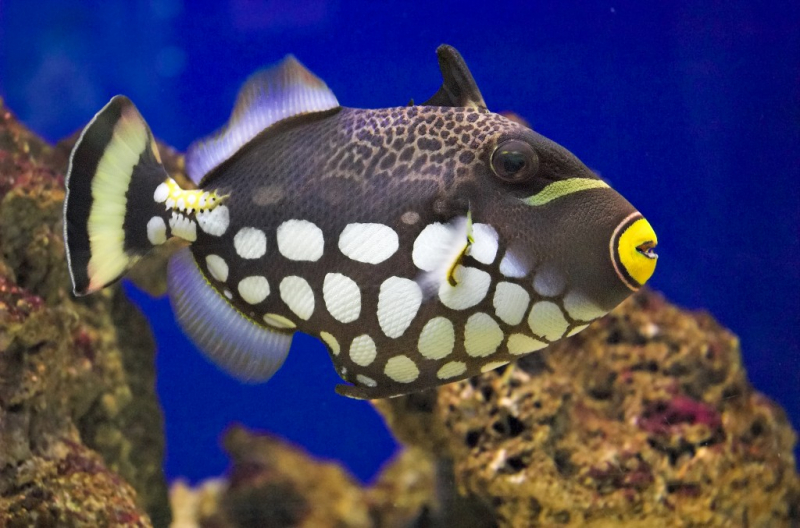
Seattle Aquarium 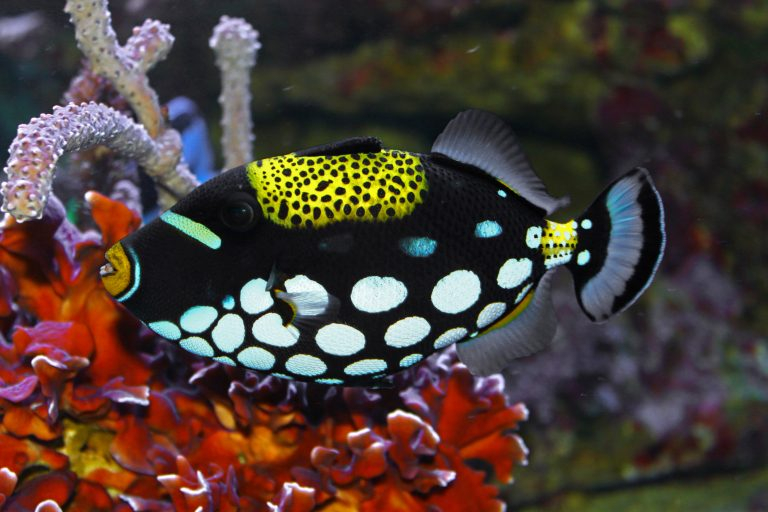
Animal Spot -
Regal Tang (Paracanthurus hepatus) is a species of Indo-Pacific surgeonfish. A popular fish in marine aquaria, it is the only member of the genus Paracanthurus. The Indo-Pacific is home to the Regal Tang. The Great Barrier Reef of Australia, the Philippines, Indonesia, Japan, New Caledonia, Samoa, East Africa, and Sri Lanka all have them as do the reefs. One of the most prevalent and well-liked marine aquarium fish in the world is the regal tang. They reside in pairs or compact communities of eight to fourteen people. On the seaweed side of coral reefs, you can also find them next to cauliflower corals.
They feature a black "palette" pattern, a yellow tail, and a royal blue body. In the western and central Indian Ocean, the bottom body is yellow. It expands to 30 cm. Males are typically larger than females and weigh about 600 g (21 oz) on average as adults. This fish has a circular body shape, a pointed, pancake-like nose, thin scales, and a flat, pancake-like appearance. The regal tang has three anal spines, 24–26 anal soft yellow rays, 26–28 dorsal soft rays, and nine dorsal spines.

Wikipedia 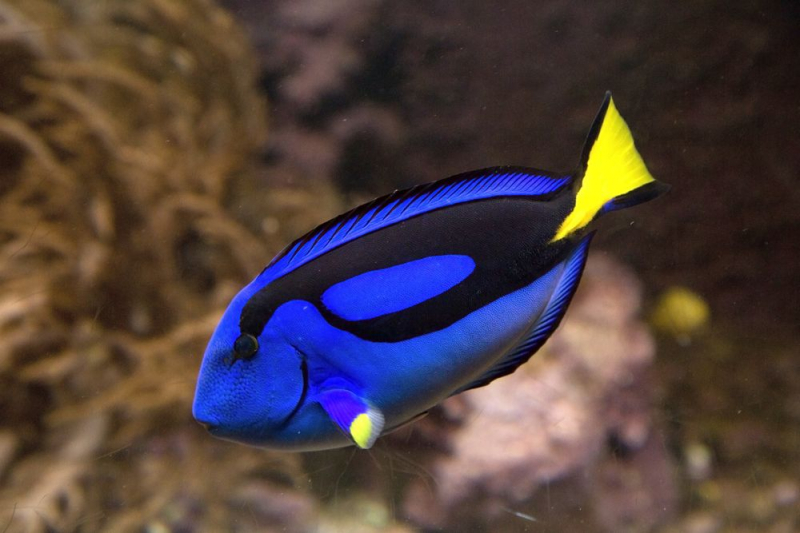
Live Science -
The French Angelfish (Pomacanthus paru) is a species of marine ray-finned fish, a marine angelfish belonging to the family Pomacanthidae. The body of the French angelfish is almost round and laterally compressed. The deep head has a short snout that ends in a tiny mouth with several bristle-like teeth. There is no spine on the operculum or under the eye, but there is a clear spine at the corner of the preoperculum. The largest overall length of this species is 41.1 centimeters. The juveniles are almost all black save from five curved vertical yellow bands on the body, the first one at the mouth and the last one at the caudal peduncle.
The French angelfish can be found in the Gulf of Mexico, the Caribbean, including the Antilles and Roatan, the western Atlantic from New York and the Bahamas to Brazil, as well as the eastern Atlantic from Ascension Island and St. Paul's Rocks. It is frequently seen near sea fans and on stony and coral reefs where it typically occurs in pairs. Sponge, algae, bryozoans, zoantharians, gorgonians, and tunicates are all part of its diet. These pairs are fiercely protective of their territory, and they frequently fight back against intruders together.
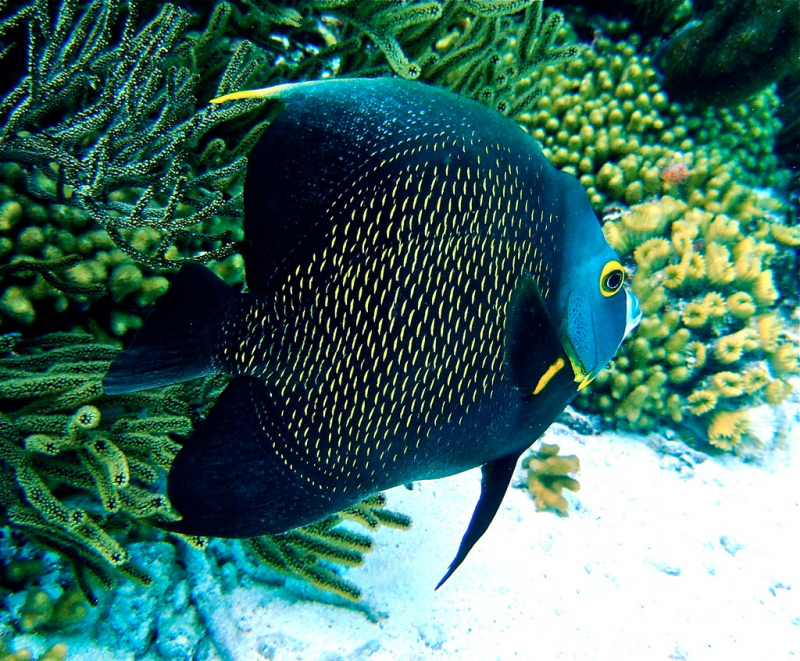
Flickr 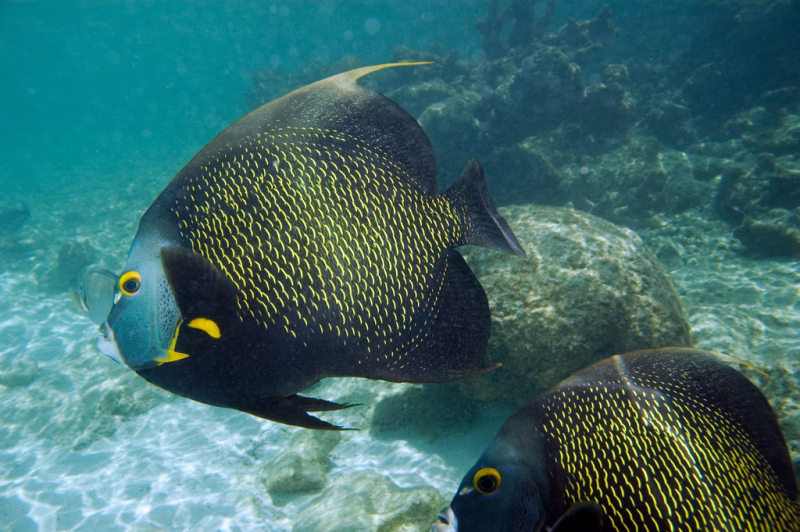
iNaturalist -
Clownfish or anemonefish are fishes from the subfamily Amphiprioninae in the family Pomacentridae. The warmer waters of the Red Sea, the Indian Ocean, the Pacific Ocean, the Great Barrier Reef, Southeast Asia, Japan, and the Indo-Malaysian region are all home to anemonefish. While the majority of species have confined ranges, others have broad dispersion. Anemonefish often inhabit protected reefs or shallow lagoons at the bottom of shallow oceans. The Atlantic Ocean does not include anemonefish.
Thirty species have been identified, with one belonging to the genus Premnas and the rest to the genus Amphiprion. They all create symbiotic mutualisms with sea anemones in the wild. Anemonefish vary in overall color from yellow to orange to reddish to black, and many have white bars or patches. The largest can reach a length of 17 cm, while the smallest barely achieve 7–8 cm.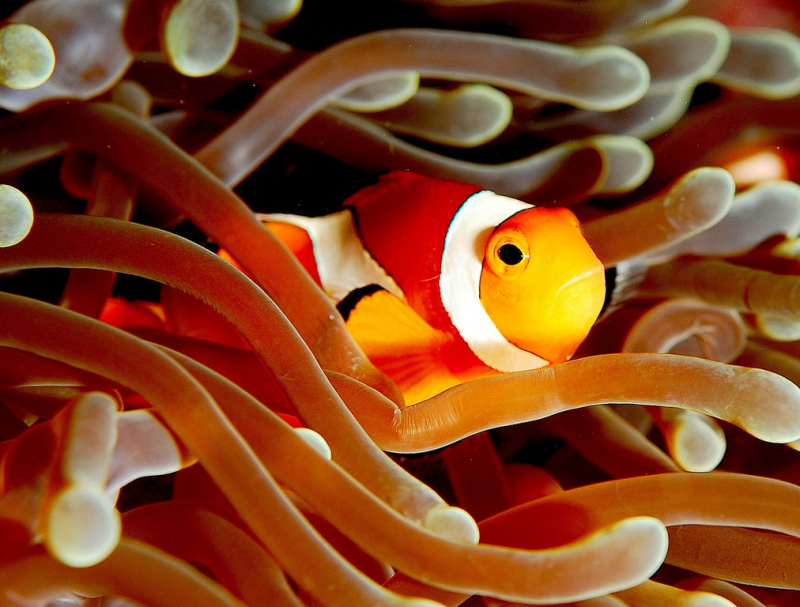
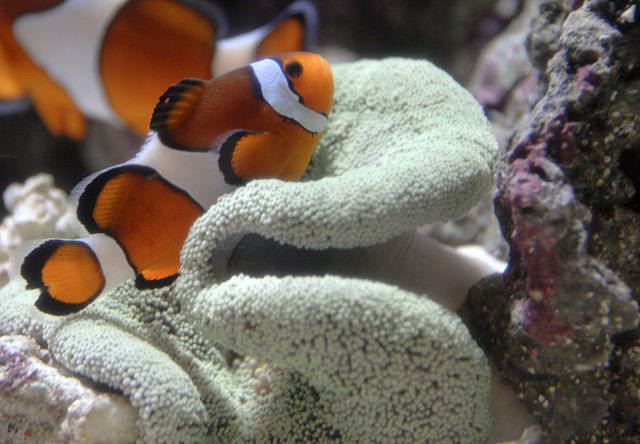
Wikimedia Commons -
In the tropics of the Pacific Ocean, the Flaming Angelfish (Centropyge loricula) is a marine angelfish belonging to the Pomacanthidae family. Other common names for angelfish are Japanese pygmy angelfish, flame angel, and fiery angelfish. The flaming angelfish has four or five bars on the sides, the back of the dorsal fin, and the anal fin, with alternating short purple-blue and black bands. It also has an elongated vertical black mark. Marquesas specimens are devoid of vertical black bars. In general, males are bigger and have slightly more color than females. The flame angelfish has a lifespan of 5-7 years or longer.
The flaming angelfish eat a variety of algae and crustaceans in the wild. Reef aquarium fish occasionally enjoy very long lives, however, when they get elderly, the majority of these fish frequently pass away mysteriously. This is understandable because many members of the Centropyge family spend their juvenile years primarily eating plankton before switching to their adult diet. Occasionally, all it takes is for a person who is undernourished to "test" a food source. Given this, angelfish are typically placed in an aquarium that has already been constructed and fed frozen Mysis shrimp or meaty crustaceans like shrimp and clams.
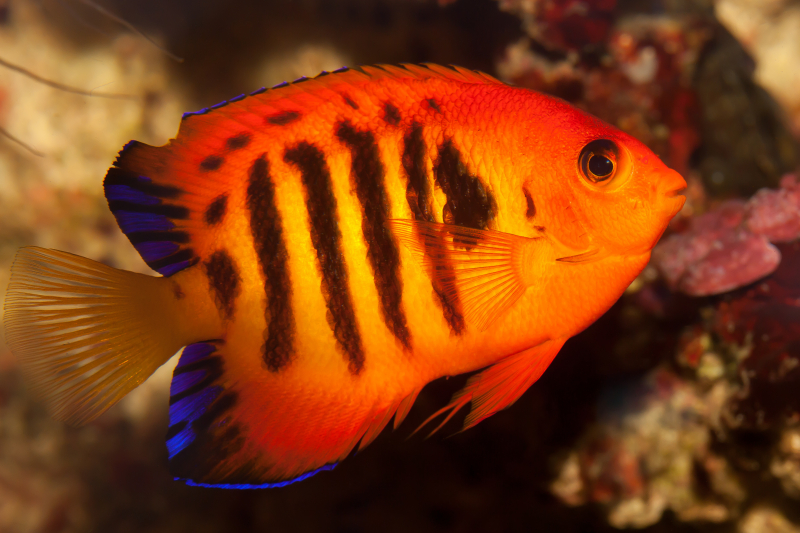
Wikipedia 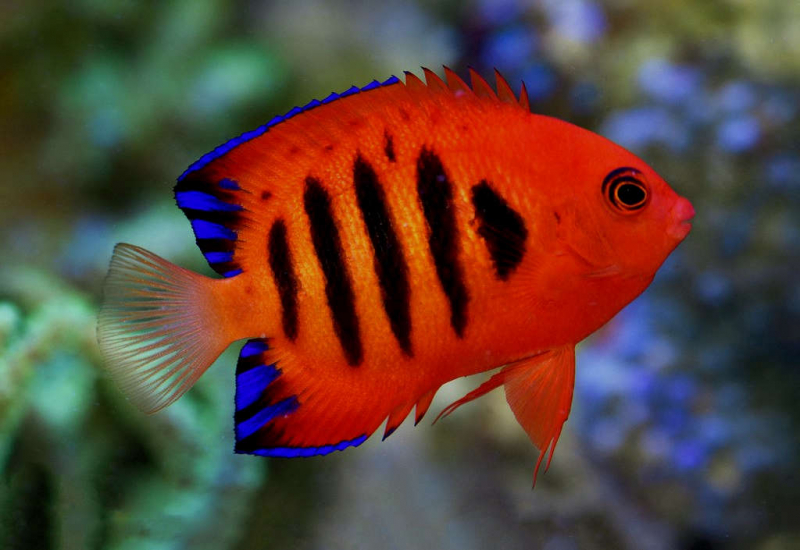
AquariumDomain.com -
The only surviving member of the family Zanclidae in the order Acanthuriformes is the saltwater fish species known as the Moorish Idol (Zanclus cornutus). The Moorish idol is renowned for its widespread presence in the Indo-Pacific. It is a frequent resident of tropical to subtropical reefs and lagoons. Many butterflyfish species (genus Heniochus) resemble the Moorish idol quite much. It is closely linked to the extinct Eozanclus brevirostris from the Middle Eocene of Monte Bolca, if not a direct descendent. The name of the Moorish idol comes from the Moors of Africa, who allegedly thought fish brought happiness. Moorish idols are a popular aquarium fish, but despite their availability in a variety of habitats and abundance, they are famously picky and difficult to acclimate to captivity.
Moorish idols are alluring to aquarium keepers because of their uniquely compressed and disk-like bodies, which stand out in contrasting bands of black, white, and yellow. Except for the dorsal fin, which has six or seven drastically enlarged spines that form a trailing, sickle-shaped crest known as the philomantis extension, the fish's fins are generally modest. Moorish idols have numerous long, bristle-like teeth lining small terminal mouths at the ends of long, tubular snouts. The Moorish idol is distinguished from butterflyfish by possessing a conspicuous, triangular-shaped black anal fin.
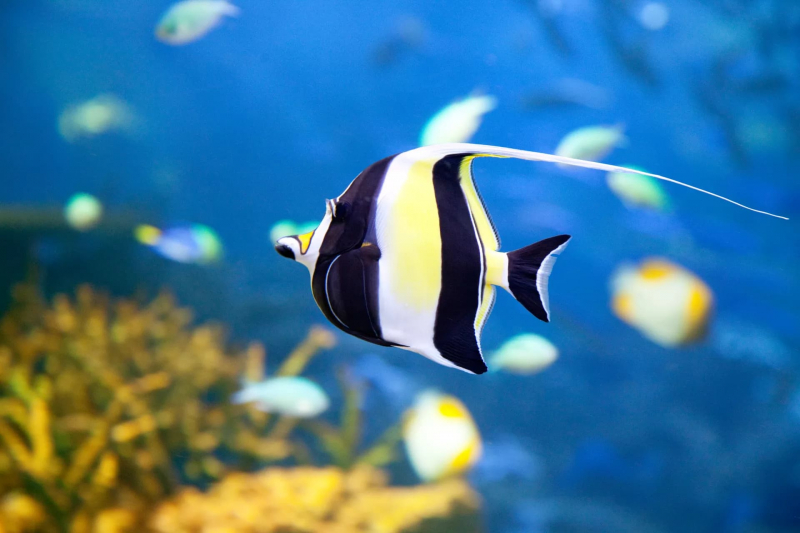
DK Find Out! 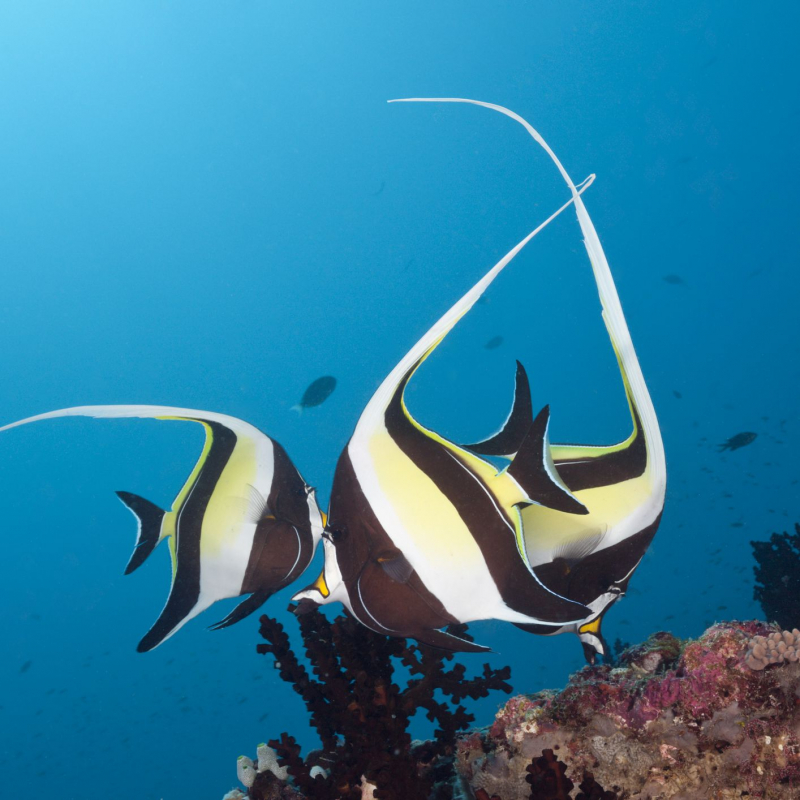
The Spruce Pets -
Southeast Asia, specifically Cambodia, Laos, Myanmar, Malaysia, Indonesia, Thailand, and Vietnam, is home to the freshwater fish known as the Betta (Siamese fighting fish). Due to their widespread appeal as pets and their comparatively low maintenance requirements, Betta splendens are among the most widely kept aquarium fish in the world. There are 73 species in the genus Betta, but only one is given the name "betta". The Siamese fighting fish is not only well-known internationally, but it is also Thailand's national aquatic animal, which continues to be the country's principal source of betta breeding and export. The IUCN has classed Betta as "vulnerable" due to rising pollution and habitat destruction, despite the fact that they are often used as pets.
Typically, B. splendens reaches a length of 6–8 cm. Although B. splendens aquarium specimens are well recognized for their vivid colors and huge, flowing fins, wild fish only display vibrant colors when they are agitated; their usual coloring is often green, brown, and grey. Siamese fighting fish have been intentionally developed in captivity to exhibit a brilliant variety of colors and tail patterns.
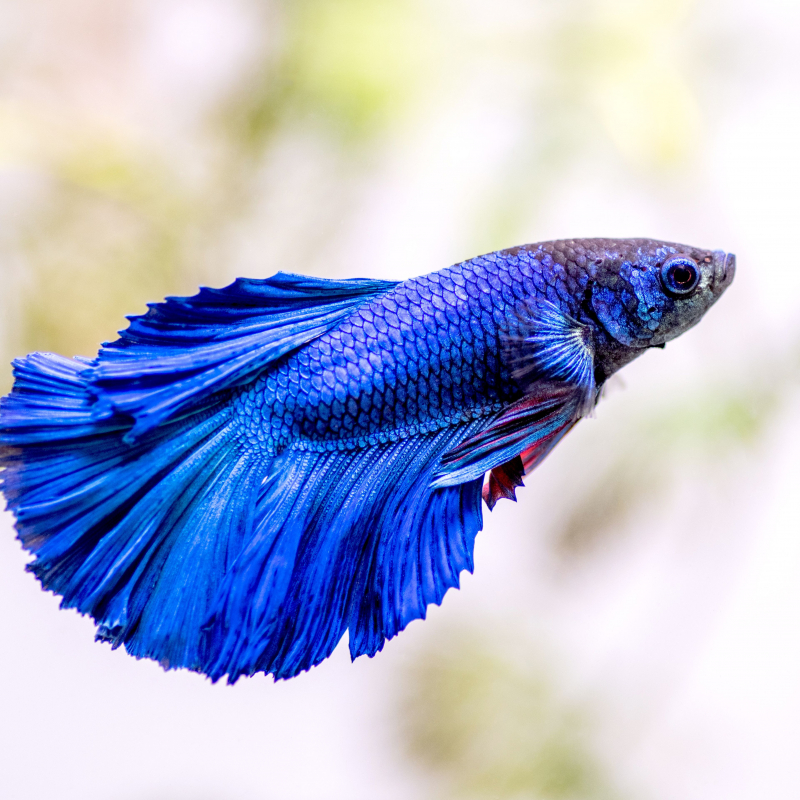
The Spruce Pets 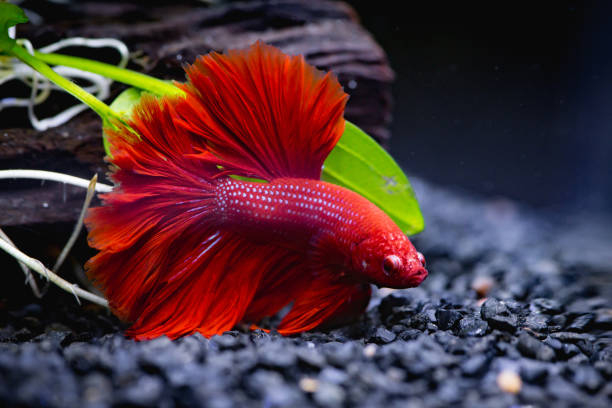
iStock













